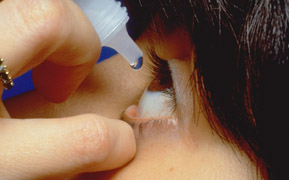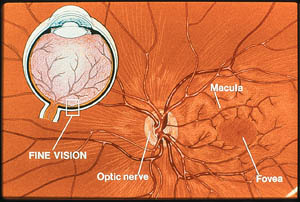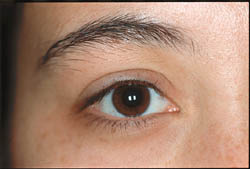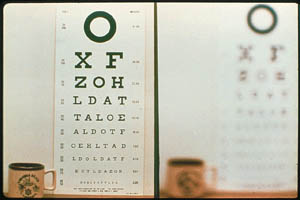
A dilated exam is one of the most fundamental aspects of a complete eye exam.
Comprehensive eye care involves:
- a thorough evaluation of the visual system
- diagnosis of disease
- management of the total patient.
This is within the domain of an ophthalmologist who is a physician and surgeon having an M.D. degree. (S)he specializes in medical and surgical diseases of the eye. Often, disorders of the visual system are a result of other problems in the body that can be recognized only by those who are medically trained. Many times, your ophthalmologist will have to collaborate with your regular medical doctor or perhaps other specialists in your care.
1. Comprehensive Evaluation of the Eye and Visual System:

Schematic drawing of the part of the eye responsible for critical central vision. The macular area is really less than 1mm (1/16th of an inch). Diseases of the macula can result in macular degeneration.
Such an evaluation not only requires an examination of the eye and surrounding tissues, but may involve analysis of the entire visual system. The visual system consists of the eye, optic nerve, nerve connections to the brain, and the brain itself. As the eye picks up light from an object, those impulses are transmitted from the eye, through the optic nerve and its connections through many parts of the brain, and finally to the part of the brain that sees (occipital lobe). The brain is a huge computer, and it is here where those electrical impulses from the eyeball itself are “decoded” into what we know as “vision.” Any interruption along the visual pathway, eyeball to brain, can result in loss of vision.
Evaluation of the eyeball starts with a measurement of your vision both distant and near, and also a test of your color vision. A refraction is then done looking for nearsightedness, farsightedness, and/or astigmatism. Examination of your pupillary responses, your muscle balance and alignment, and your side vision are done. The surrounding tissues and supporting structures and evaluated for any asymmetry of abnormality. A SLIT LAMP exam is then done which allows microscopic evaluation of the internal eye structures and surrounding tissues.
A glaucoma pressure check is done, and a dilated exam often follows looking for cataracts, retinal and optic nerve abnormalities, retinal circulatory disturbances
from diabetes, macular degeneration, and others. If abnormalities are found, additional testing may be necessary.

THE EYE IS THE WINDOW TO THE CENTRAL NERVOUS SYSTEM
It is said that the eyes are the window to the nervous system. This means that the visual system has such extensive representation in the brain that virtually anything that happens inside the head will result in some abnormality through the eyes. The abnormality could show through abrupt loss of vision, reduced vision or color vision, double vision, an abnormality in peripheral (side) vision, disturbances in pupillary function, problems with how the eyes move or align together, poor ocular coordination, jerky eye movements, light sensitivity, and others. If there is suspicion that there is a neurologic problem, further evaluation can be done with scans, a variety of lab tests, and consultations with other specialists.
2. Diagnosis

Example of “tunnel vision” seen with diseases such as Retinitis Pigmentosa. Diseases of the Occipital Lobe (part of the brain responsible for vision) can also cause tunnel vision.
Diagnosis is possible only after a good history, review of past history, previous medical problems, medications that you may be taking, etc. a thorough clinical evaluation, and review of any additional tests. For difficult diagnoses, consultation with other physicians may be necessary. In all cases, a thorough understanding of systemic diseases of the body and how they affect the eyes is critical.
3. Treatment of the WHOLE
Patient: Dealing with blindness and other visual disorders requires dealing with the whole patient, their aspirations, lifestyles, and helping to work out workable solutions to allow them to be as independent and
functional as possible despite their visual handicap.

Legal blindness is vision less than 20/200 on a standard Snellen eye chart. This patient had advanced cataract disease.
Example of “legal” blindness. Blindness isn’t only total absence of vision such as being in a dark room. There are many forms of blindness such as color blindness, night blindness, etc.
It also involves an understanding of body disease, how it affects the eyes in late stages, and how to intervene BEFORE disease destroys vision. This often involves close collaboration between the ophthalmologist and other medical specialties. Diabetic eye disease is an excellent example of how the team approach among medical disciplines help control the disease and monitor for progression that could ultimately rob a patient of their eyesight.
